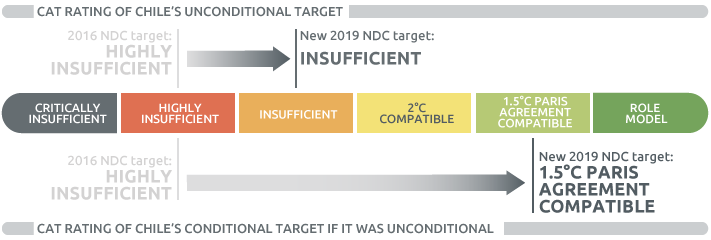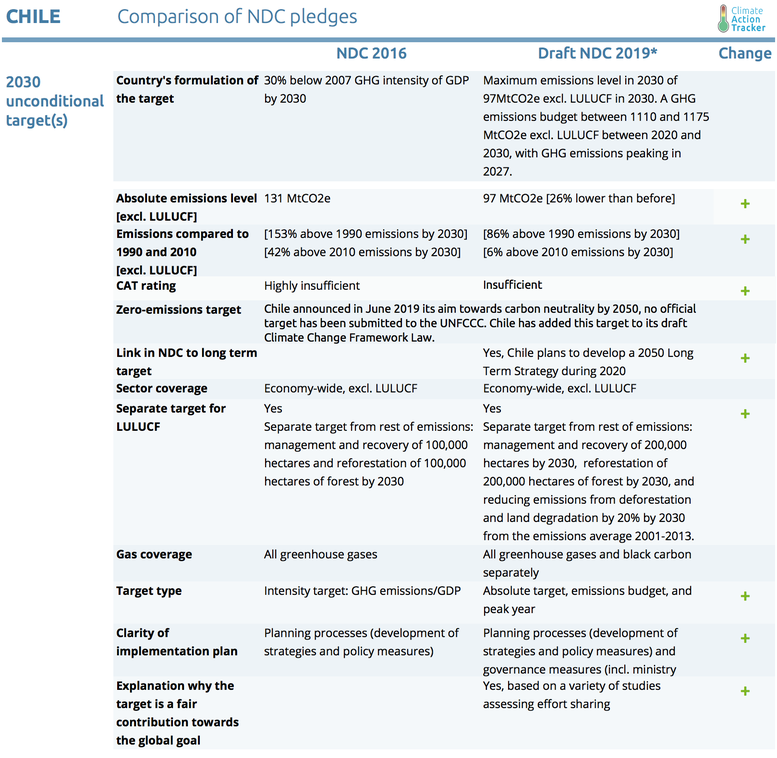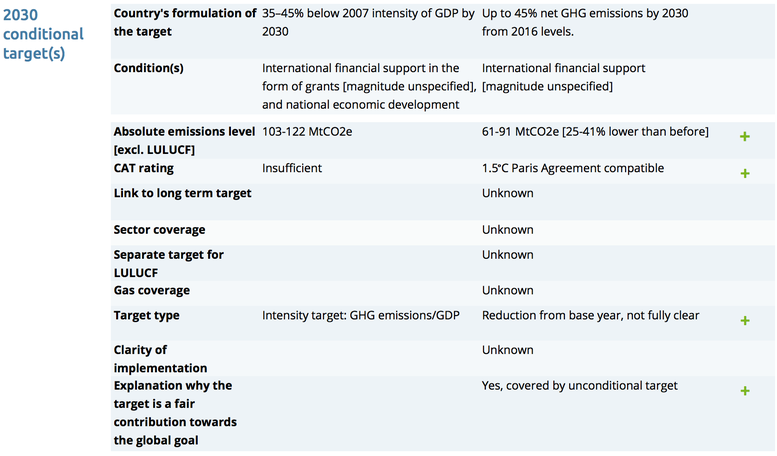Summary


Chile's draft NDC update 2019
Chile’s NDC update proposal was released for public consultation in October 2019 (Ministerio del Medio Ambiente de Chile, 2019). Its unconditional 2030 target has improved one CAT rating to ‘Insufficient’. Depending on the assumptions made, its conditional 2030 target would be 2°C or 1.5°C compatible, but only if it were unconditional. Both targets are more ambitious, therefore this update represents a progression beyond its current NDC.
Scroll down for a detailed analysis of Chile’s NDC update or click the button to view the latest CAT assessment for Chile.
CAT analysis of draft unconditional target

The proposed unconditional NDC provides improvements in transparency, ambition and governance. If Chile were to officially adopt this plan, we would rate it “Insufficient.”
The “Insufficient” rating indicates that Chile’s proposed updated unconditional climate commitment in 2030 is not consistent with holding warming to below 2°C, let alone limiting it to 1.5°C as required under the Paris Agreement, and is instead consistent with warming between 2°C and 3°C. If all countries were to follow Chile’s approach, warming would reach over 2°C and up to 3°C. This means Chile’s climate commitment is at the least stringent end of what would be a fair share of global effort, and is not consistent with the Paris Agreement’s 1.5°C limit, unless other countries make much deeper reductions and comparably greater effort.
Details of draft unconditional target
The draft unconditional target proposed by Chile includes three components:
- An economy-wide target excl. emissions or removals from the Land Use, Land Use Change and Forestry (LULUCF) sector of 97 MtCO2e in 2030.
- GHG emissions budget of between 1110 and 1175 MtCO2e between 2020 and 2030
- A peak year for GHG emissions: 2027
In addition, there are three sub-targets for the LULUCF sector:
- Sustainable management and recovery of 200 000 hectares of native forest, equivalent to a GHG emissions capture between 0.9 and 1.2 MtCO2e/yr by 2030
- Reforestation of 200 000 hectares of forest, from which at least half correspond to permanent forest coverage, from which at least 70 000 hectares should be native species. This is equivalent to a GHG emissions capture between 3 and 3.4 MtCO2e/yr by 2030
- Reduce emissions from deforestation and land degradation of native forest by 25% by 2030, taking average emissions between 2001-2013
This proposal specifies linking its 2030 target to its long-term goal for carbon-neutrality in 2050 as well as linking the NDC targets to planning processes involving governance, existing and future strategies including the “Long-term Climate Strategy 2050.”
CAT analysis of draft conditional target

The proposed updated conditional target - subject to climate finance - is close to or compatible with Chile’s fair share Paris Agreement’s 1.5°C range. However, in contrast to the unconditional NDC proposal, this target provides no clarity on sectoral coverage, rendering it difficult to evaluate. For our analysis we have assumed that reductions from “net emissions in 2016” refers to economy-wide emissions incl. LULUCF in 2016, and thus estimated a range of total emissions excl. LULUCF in 2030 based on the following assumptions:
- For the upper end of the range we have estimated total emissions excl. LULUCF as the difference between total emissions incl. LULUCF and LULUCF emissions in 2030 if the first are a 45% reduction from those in 2016 and LULUCF emissions are the same as in 2016.
- For the lower end of the range we have total emissions excl. LULUCF in 2030 as a 45% reduction of total emissions excl. LULUCF level in 2016. The LULUCF level then is estimated as the difference between total GHG emissions incl. LULUCF and total GHG emissions excl. LULUCF.
Depending on the assumptions made, this target could be rated either “2°C compatible” or “1.5°C Paris Agreement compatible”, but only if it were unconditional. If this conditional target were to refer to a 45% GHG emission reductions from 2016 economy-wide emissions excl. LULUCF and were made without conditions, the CAT would rate it “1.5°C Paris Agreement compatible,” indicating efforts in the most stringent part of Chile’s fair share range.
The CAT estimates that by implementing all of its planned policies, Chile could peak its emissions in 2023, which would be earlier than the proposed peak in 2027, this would be a remarkable achievement and set the country up as a front-runner on climate action. Under this scenario the carbon budget between 2020 and 2030 would be 5-9% lower than the carbon budget presented in the draft NDC update document.
Details of draft conditional target
The proposed by Chile also contains:
- a target to reduce black carbon emissions by 10% - 25% below 2016 emission levels, by 2030, and
- two adaptation targets:
- one including administrative measures on the sectoral adaptation plans, and
- a second including the sectoral adaptation targets.
Details of other supporting targets
Black Carbon and Chile’s NDC
The draft NDC also includes a target to reduce black carbon emissions by 10% - 25% below 2016 emission levels, by 2030. It also has two adaptation targets: one including administrative measures on the sectoral adaptation plans, and a second including the sectoral adaptation targets.
Chile’s proposed NDC update includes a target to reduce black carbon emissions, which has substantial co-benefits for human health. However, reductions in black carbon are generally not additional to reductions in CO2 emissions, because large fractions of black carbon emissions stem from the same emission sources as CO2. Emission reduction policies therefore often reduce CO2 and black carbon simultaneously, and this is already included in calculations of the emissions reductions required to hold warming well below 2°C globally, like the “emissions gap” and “fair share” reductions (see the Fair Share section on the CAT country analysis for Chile).
In its most recent Fifth Assessment Report (AR5) (IPCC, 2014), the IPCC did not provide calculations of Global Warming Potential for black carbon comparable to those provided for greenhouse gases, merely noting the inherent difficulties in doing so and limiting itself to displaying estimates from the pre-AR5 literature.
Sources
- Ministerio del Medio Ambiente de Chile (2019) ‘Primer proceso de Actualización de la Contribución Determinada a Nivel Nacional (NDC)’. Santiago de Chile: Ministerio del Medio Ambiente, Chile. Available at: http://consultasciudadanas.mma.gob.cl/mma-epac/app/obtenerDocumentoAntecedente?ruta=%2Fconsulta%2Fantecedentes%2F9bb8ebd7-f2cc-464b-9dc7-bd39062d059b.pdf
- IPCC, 2014. Climate Change 2014: Mitigation of Climate Change, Working Group III Contribution to the Fifth Assessment Report of the Intergovernmental Panel on Climate Change. Cambridge University Press, Cambridge, United Kingdom and New York, NY, USA. https://doi.org/10.1017/CBO9781107415416
Links
Stay informed
Subscribe to our newsletter


